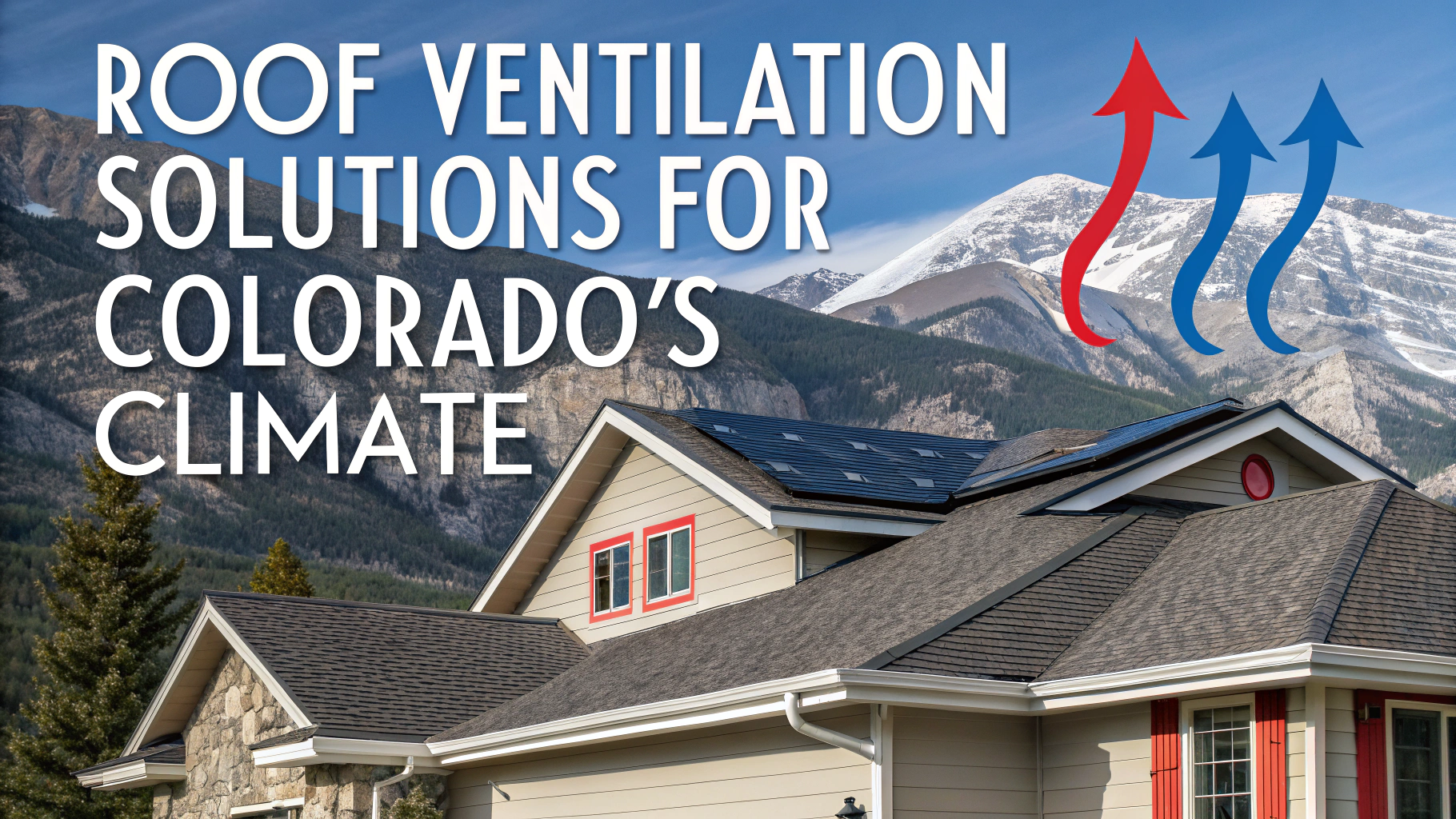Colorado’s unique climate poses specific challenges for home ventilation, making proper roof ventilation essential for maintaining comfortable indoor temperatures and protecting your home’s structure.
From scorching summer heat to heavy winter snowfall, an effective roof ventilation system helps regulate temperatures, prevent ice dams, and extend the lifespan of your roofing materials.
This guide explores the best roof ventilation solutions specifically designed for Colorado’s diverse weather conditions.
Types of Roof Ventilation for Colorado Homes
- Ridge Vents: Install along the peak of the roof, providing consistent airflow
- Soffit Vents: Placed under the eaves to allow fresh air intake
- Solar-Powered Attic Fans: Perfect for Colorado’s 300+ sunny days
- Wind Turbines: Utilize natural wind patterns for ventilation
- Gable Vents: Located at the ends of attics for cross-ventilation
Climate-Specific Considerations
High-altitude locations require specialized ventilation calculations based on the thinner air and increased UV exposure.
Mountain regions need robust snow-guard systems integrated with ventilation to prevent ice dam formation.
Front Range homes benefit from combined ridge and soffit ventilation to handle extreme temperature swings.
Recommended Ventilation Solutions by Region
| Region | Primary Solution | Additional Recommendations |
|---|---|---|
| Denver Metro | Ridge/Soffit Combination | Solar-powered fans for summer |
| Mountain Communities | Heavy-duty ridge vents | Ice dam prevention systems |
| Western Slope | Solar-powered ventilation | Additional intake vents |
Installation and Maintenance Tips
- Schedule annual inspections before winter
- Clear vents of debris quarterly
- Check seals and flashings during spring
- Monitor attic temperature regularly
- Ensure proper insulation complements ventilation
Professional Installation Contact Information
For professional installation in Colorado, contact:
- Colorado Roofing Association: (303) 484-0549
- Denver Building Department: (720) 865-2705
- Colorado Springs Regional Building Department: (719) 327-2880
Energy Efficiency Benefits
Proper roof ventilation can reduce cooling costs by up to 15% during Colorado summers.
Winter heating efficiency improves through reduced ice dam formation and better moisture control.
Energy Star certified ventilation products qualify for local utility rebates in many Colorado counties.
Next Steps for Your Roof
Schedule a professional roof inspection to assess your current ventilation system.
Request quotes from at least three licensed Colorado roofing contractors.
Check local building codes and obtain necessary permits before installation.
Seasonal Maintenance Schedule
Follow these seasonal guidelines to maintain optimal roof ventilation:
Spring
- Remove winter debris from all vents
- Inspect for winter damage
- Check all seals and gaskets
- Test mechanical ventilation systems
Summer
- Monitor attic temperatures during peak heat
- Clean solar-powered fan panels
- Verify proper airflow patterns
- Address any hot spots immediately
Common Ventilation Problems in Colorado
Watch for these regional-specific issues:
- Inadequate ventilation for high-altitude conditions
- Improperly sized intake/exhaust ratios
- Snow blockage in mountain regions
- UV damage to exposed components
- Incorrect placement of vents for local wind patterns
Cost Considerations
| Ventilation Type | Average Cost Range | Lifespan |
|---|---|---|
| Ridge Vents | $400-$800 | 20-25 years |
| Solar-Powered Fans | $600-$1200 | 15-20 years |
| Wind Turbines | $200-$600 each | 15-20 years |
Protecting Your Colorado Home’s Future
Investing in proper roof ventilation is crucial for Colorado homeowners. The right system not only extends roof life but also provides year-round comfort and energy savings.
Regular maintenance and professional inspections ensure your ventilation system performs optimally throughout Colorado’s challenging weather patterns.
Consider your specific regional needs and work with certified contractors to implement the most effective ventilation solution for your home’s location and design.
FAQs
- What type of roof ventilation is best suited for Colorado’s extreme climate?
A combination of ridge vents and soffit vents provides optimal ventilation for Colorado homes. This system creates a continuous air flow that helps manage temperature extremes and moisture throughout the year. - How does proper roof ventilation help during Colorado’s heavy snow seasons?
Proper ventilation prevents ice dam formation by maintaining a consistent roof temperature, which helps snow melt evenly and reduces the risk of water damage and structural issues. - What are the signs of inadequate roof ventilation in Colorado homes?
Common signs include excessive energy bills, ice dam formation in winter, hot attic spaces in summer, moisture accumulation, premature shingle aging, and visible mold or mildew in the attic. - How many roof vents does a typical Colorado home need?
The standard requirement is 1 square foot of ventilation for every 300 square feet of attic floor space, split evenly between intake and exhaust vents. High-altitude homes may require additional ventilation. - Should I install a power vent in my Colorado home?
Power vents can be beneficial in areas with limited natural airflow, but they’re not always necessary. In Colorado’s climate, properly installed passive ventilation systems are often sufficient and more energy-efficient. - How does altitude affect roof ventilation requirements in Colorado?
Higher altitudes experience thinner air and more intense UV exposure, requiring increased ventilation capacity. Homes above 5,000 feet may need up to 20% more ventilation than sea-level homes. - What impact do Colorado’s temperature swings have on roof ventilation?
Colorado’s dramatic temperature variations make proper ventilation crucial. A well-ventilated roof helps regulate temperature extremes, preventing condensation in winter and heat buildup in summer. - How often should roof ventilation systems be inspected in Colorado?
Roof ventilation systems should be inspected twice yearly: in spring after snow season and in fall before winter. Additional inspections are recommended after severe storms or hail events. - What role do solar-powered vents play in Colorado’s roofing systems?
Solar-powered vents can be effective supplementary ventilation, especially in areas with high sun exposure. They’re most efficient during summer months when additional attic ventilation is needed. - How can I protect roof vents from Colorado’s heavy snow loads?
Install snow guards around vents, use heavy-duty vent covers, and ensure proper insulation around vent openings. Regular maintenance to clear snow accumulation is also essential.
